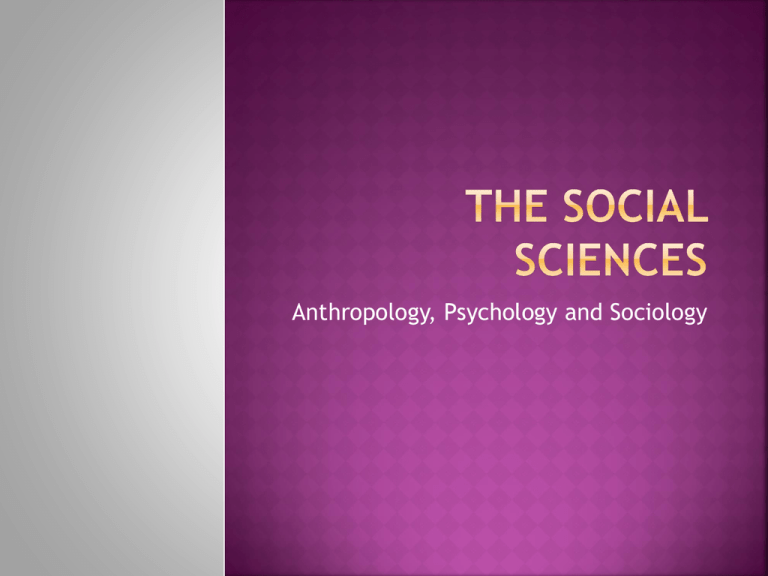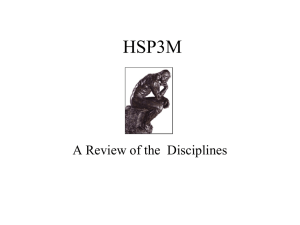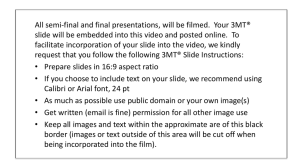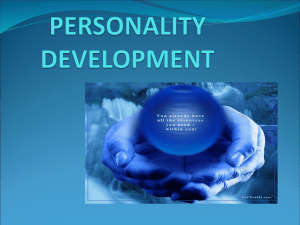1.1 Social Science Intro PPT
advertisement

Anthropology, Psychology and Sociology 26 people died – 20 children and 6 adult staff Gunman found dead inside the building Gunman’s mother found dead in her home – 27 dead total Second deadliest school shooting in US history, behind Virginia Tech massacre http://www.youtube.com/watch?v=ItsOJUpK -cY BIG QUESTION: WHY DID THIS HAPPEN?? Questions asked are based on the discipline – different questions are asked for each Psychology – the systematic study of people’s thoughts, feelings (mental processes), and behaviour Reasons thus are largely attributed to personality (including potential mental illness) Assumption: Psychologists assume that an individual’s personality is moulded by a combination of biological factors (hereditary traits – genetics) and prior experiences… nature and nurture Sociology – the scientific study of human social behaviour and the institutions and organizations that form society; the study of how groups of people who share common characteristics function Includes the study of how groups of people who share some common characteristic(s) function Looks for common factors (commonalities) Assumption: an individual’s acts can only be understood when they are compared with the acts of similar individuals Anthropology – the study of the origin of behaviour, and the physical, social and cultural development of humans Looks at the values of the cultures which people grow up and later work Assumption: that there are factors in a culture, in general, and in subcultures, in particular, that encourage or discourage particular behaviours http://www.breakingnews.ie/world/canadia ns-ignore-beaten-naked-teenage-girl12940.html How did the environment ( workplace, neighbourhood) influence the decisions of the people involved? What violent experiences had there been in this community that would affect employee’s reaction? Could cultural factors have influenced decisions? Why did people not call for help? Why did they obey their supervisor? What factors led the girl to this location? What was the supervisor thinking and why? (prior experiences, personality) What factors influenced the decisions of the supervisor, the employees who did not respond, and the employee who did make the 911 call? Was the fact that the supervisor was an authority figure important? Were there any factors, such as gender, race, age, or economic status, that might have influenced the assumptions of the supervisor and employees? (Group, Social,Organizational dynamics) Read the handout of the 1999 OC Transpo murders In groups of 2 explain what main question each discipline would ask to help understand this event Include their explanation based on the information presented in the handout Psychologists would examine his life in detail in order to answer: What factors in his personalityor past led Lebrun to commit this crime? Assume that personality is moulded by a combination of biological factors as well as prior experiences Lebrun had made 50 visits to doctors complaining of stomach cramps, insomnia, depression, diarrhea and other ailments He had suffered from delusions He had been bullied at work for a speech impediment Sociologists would be interested in answering: What common sociological factors are there in the lives of people who have gone on shooting sprees at their former place of work? Some common characteristics of people who have gone on shooting rampages are: - unpopular loner - low tolerance for frustration and anger - harassed at work - low self-esteem - own/possess rifles and other guns Anthropologists would be interested in: What were the values of the culture in which he grew up & later worked? Assumption is that there are factors in Canadian culture and the “subculture” of OC Transpo that encouraged Lebrun’s behaviour Powerful images of violence are widespread in today’s Canadian culture (sports, media, video games) Evidence at the OC Transpo inquest revealed a poisonous environment, characterized by hostility and aggression There was little respect between managers and employees “Macho” behaviour was reported with much talk about women and teasing Lebrun for his stutter Cultural message in media… “When things get out of hand, acting violently will gain the attention and even respect of others.” True or false? Brainstorm ways in which the message is or is not perpetuated. What impact does this message have on a) children, b) youth, c) adults What other values are present in our culture/subculture? Is there pressure to accept the values of cultures and/or subcultures in order to fit in and be accepted? How might an anthropologist, psychologist and a sociologist explain the following incidents? a) A group of thugs attack and injure two men they see coming out of a gay bar b) A church group sponsors a refugee family from a war-torn country c) Canadian peacekeeping troops put their lives at risk in a foreign country, where a civil war has just ended but may break out again d) Soccer fans overseas riot and get into fist fights with opposing fans after a World Cup qualifying game Aldershot has asked you to conduct a study on stress experienced by students over school workload and part-time jobs. A) Which different groups would you consult? Explain why you would choose those groups. B) What questions would you ask them? Label each question as belonging to A, P, or S and explain why they fall into that category and why they’re important to ask. C) What other evidence would you want to gather? Why would it be helpful/important? D) What process would you go through to come up with a recommendation?











